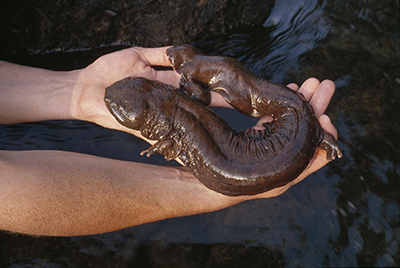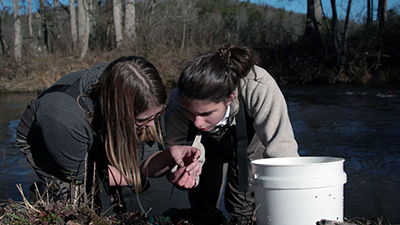
The rivers and creeks pouring off the southern Appalachian mountains are home to the nation’s most biodiverse mix of fish, mollusks and snails, many of which are imperiled by over-development and agricultural runoff.
Here, within the folds of the Chattahoochee National Forest, flows Betty’s Creek, home to the homely, elusive and very much at-risk eastern hellbender salamander.
Private landowners, including a private school along the stream’s lower reaches, work diligently to restore Betty’s Creek and save the hellbender. Rabun Gap-Nacoochee School also operates a profitable cow and corn farm that straddles the stream. The school’s financial health is intertwined with the creek’s health too.
The salamander will be considered for a threatened or endangered listing by the U.S. Fish and Wildlife Service later this year. Don Imm, the Service’s field supervisor for Georgia, says landowners would like to avoid that.
“If the species is conserved through proactive actions, and does not warrant listing, they’ll have a lot more flexibility in how they use their land,” he said.
Betty’s Creek, though, means much more to the school than mere money. Students from sixth grade through high school monitor the hellbender’s habitat, test water quality, analyze the food chain and restore streambanks. Their labor of love is also reflected in their grades and presented to the public in an end-of-year science fair. They, as much as adjoining farmers, have a significant stake in the hellbender’s health.
“As a school, and a community, we are a very important part of the watershed and we want to keep it safe because it impacts so many other things in society and nature,” said Claren Spivey, a seventh-grader who’d just finished monitoring the salamander’s habitat one recent February morning. “As private citizens we should really try to preserve what we have instead of ruining it.”
Three inches of rain fell the night before. Betty’s Creek was running fast and muddy. A dozen seventh-graders waded into the stream in search of crawdads, darters, sculpins and macro-invertebrates. They checked the stream’s pH and dissolved oxygen levels. They sought hellbender evidence.
Johnathan BySura, their science teacher, positioned himself mid-stream below a pink ribbon tied to an overhanging branch which marked the location of a so-called hellbender hut. He extended a waterproof camera into the cold water and, through an opening, into the 50-pound, tear-shaped, concrete box carefully positioned for hellbender use.
No salamander, aka “snot otter,” “lasagna lizard” and “devil dog.” But that’s not unusual. The slime-covered hellbender — the nation’s largest amphibian which can reach 2 feet in length — needs cold, clear, rushing mountain water and big rocks to burrow under. Its traditional habitat stretched from upstate New York to southern Missouri to the foothills of the southern Appalachians.
Today, though, hellbender sightings are rare. The Ozark hellbender is a federally endangered species found, sometimes, in southern Missouri and northeastern Arkansas. A decision whether to list the eastern hellbender on the federal Endangered Species Act will be made later this year.
Betty’s Creek is vitally important for the salamander. Two years ago BySura’s students found the only documented hellbender in the stream. The Georgia Department of Natural Resources with help from the Orianne Society, a Georgia-based nonprofit dedicated to amphibian and reptile conservation, have tallied more than 600 hellbenders across northeast Georgia since monitoring began in 2011.
Other streams across the Upper Little Tennessee River watershed show more promise, as do mountain streams in western North Carolina and eastern Tennessee.

“We’ve got some really good habitat in Georgia, but we have some challenges to some of the streams impacted by agriculture,” said Thomas Floyd, a wildlife biologist with the Georgia DNR. “The hellbenders are still holding on, we think. But they’re in pretty steep decline in that watershed.”
Since 2011, the Service and the states have determined that 125 species in the eastern United States don’t need federal protection due to conservation actions, a lack of information or research evaluating threats to their survival. An additional 16 species already protected under the Endangered Species Act require less protection or no protection at all as a result of recovery actions.
Dirt runoff from construction and road sites flows into streams. Cows and horses foul the creeks while kicking up sand. Truck farms wash fertilizer and other chemicals into the water. Sedimentation fills in the crooks and crevices hellbenders seek for shelter and reproduction.
“If you drive through the Betty’s Creek watershed, you see cattle, horses and houses all the way up to the headwaters,” BySura said. “That sedimentation plays a big role in the health of the creek, especially for the hellbender.”
Rabun Gap-Nacoochee once contributed to the creek’s ecological woes. Cows, horses and sheep roamed the pastures leading to the stream’s edge. But the dairy closed in the early 1970s and the sheep and horses were carted away.
Most of Betty’s Creek, as well as a tributary, has been fenced off. Stream banks have been bolstered to keep erosion in check. Two years ago, with assistance from the Service and the U.S. Department of Agriculture, a watering system was installed to keep cows from drinking creek water.
Today, about half of the 1,400-acre campus is either pasture for 300 beef cattle or cropland for tomatoes, sweet corn, cabbage and peppers. (Not all fields or pastures drain into Betty’s Creek.) Cows cross the stream in only one spot to get from one pasture to another. The private school switched drinking water sources from a creek tributary to the county system. About 200,000 gallons of additional water now flow daily into Betty’s Creek.
“It was in a lot worse shape than it is now,” said Woody Malot, the school’s sustainability director and physics teacher. “We’ve been working on it little by little. We’ve got good management practices on our school property. I don’t think we’re adding a whole lot of degradation to Betty’s Creek.”
Back on the streambank, BySura pointed to a spot mid-creek. The concrete lid of a hellbender box was barely visible beneath the churning, turbid water. Ten boxes were placed in the school’s stretch of the creek two years ago. No hellbender has been found in any box.
Floyd, the Georgia biologist, said that’s not unusual given the short time period. He’s keen to add 50 more hellbender huts across northeast Georgia, thanks to a Southeastern Association of Fish and Wildlife Agencies grant. In all, six states will divvy up $500,000 to place boxes, study hellbender habitat and search for other populations across the region.
The states and the feds, though, need more help.
“In the last 10 years we’ve realized we can’t recover these species by ourselves,” said Imm, the Service biologist. “And, in the east, private landowners are the principal property owners, acreage-wise. We need the involvement of local landowners, communities and governments.”
Neither Imm nor Floyd want the hellbender to be listed.
“It’s always easier to work with non-listed species because of the potential regulatory burdens,” Floyd said. “You can’t expect a private landowner to provide an ecological service without compensation. It takes more money than most folks have in order to make sure those stream banks are secure.”
Rabun Gap-Nacoochee will do its part. Middle-schoolers will continue monitoring the stream’s health and hellbender habitat. High schoolers will continue eDNA sampling along the creek. All information will be presented at an end-of-year Watershed Festival open to the community.
“It’s great for the environment even if it’s on such a small scale,” said Ella Loveland, a seventh-grader with a passion for the outdoors. “We need to do this work too, even if the government is doing it as well.”
 Sign In
Sign In
 Sign In
Sign In
